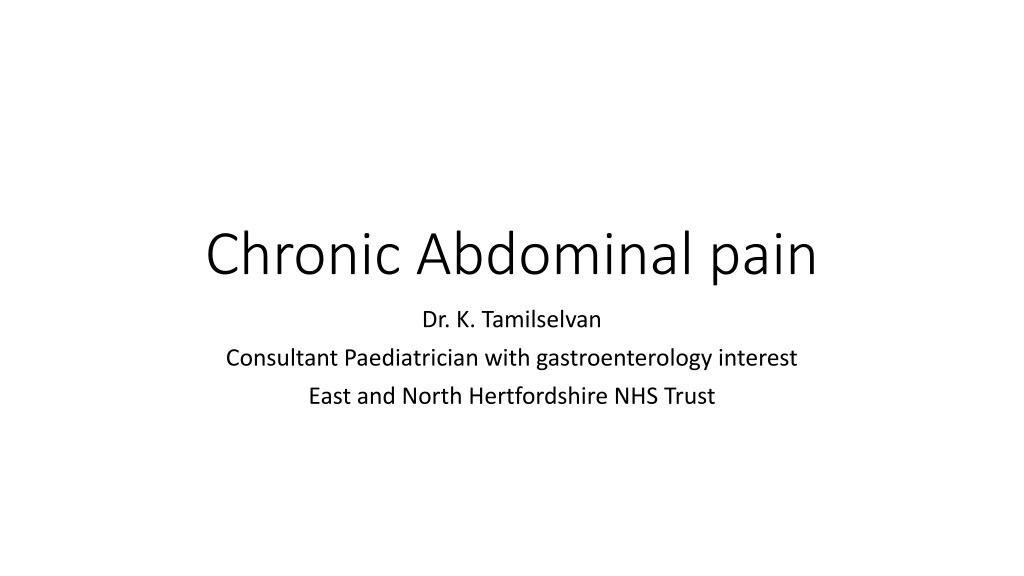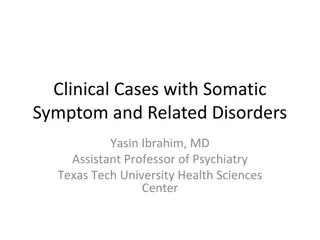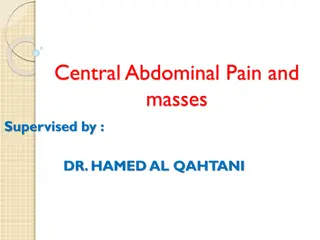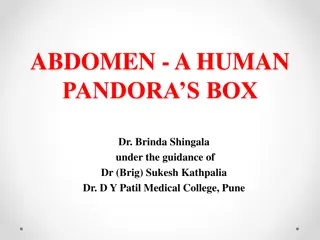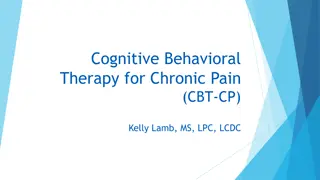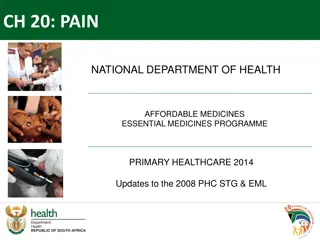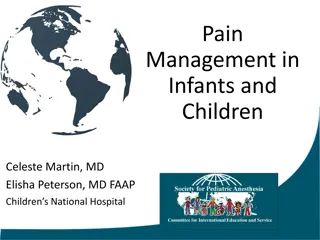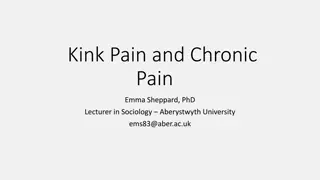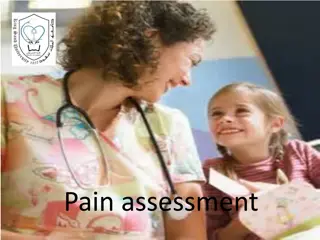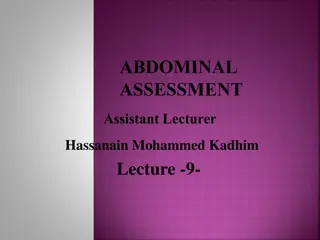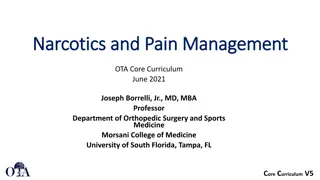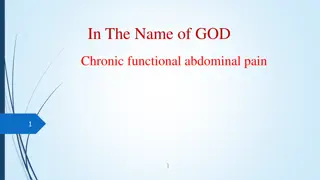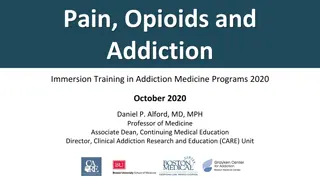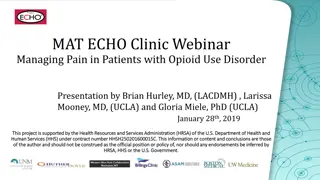Understanding Chronic Abdominal Pain in Children: Causes, Diagnosis, and Treatment
Chronic abdominal pain in children is a common issue, with underlying organic diseases being relatively uncommon. Factors such as stress, parental anxiety, and genetic predisposition can contribute to these symptoms. It is crucial to differentiate between functional and organic GI disorders through accurate diagnosis based on robust symptom criteria like the Rome criteria, leading to appropriate treatment and improved quality of life for affected children.
Download Presentation

Please find below an Image/Link to download the presentation.
The content on the website is provided AS IS for your information and personal use only. It may not be sold, licensed, or shared on other websites without obtaining consent from the author. Download presentation by click this link. If you encounter any issues during the download, it is possible that the publisher has removed the file from their server.
E N D
Presentation Transcript
Chronic Abdominal pain Dr. K. Tamilselvan Consultant Paediatrician with gastroenterology interest East and North Hertfordshire NHS Trust
Aims & Objectives Introduction Causes/ Associate factors Functional GI disorders Rome criteria Presenting symptoms and signs Differential diagnosis Investigations Treatment Primary care pathway Take home messages
Introduction Chronic abdominal pain/ Recurrent abdominal pain/ Functional abdominal pain Very common - 10-15% children in UK 5-10% have underlying organic disease It is uncommon < 4 years F>M
Causative factors Visceral hyperalgesia/ altered brain-gut interaction/ cortical nociceptive abnormal wiring Research Functional MRI in healthy subjects vs adolescents with IBS - Structural and functional differences in brain - reinforces the theory of psychological aspects of treatment Gut microbiota
Associated & Risk factors Associated factors stress - significant event - less coping strategies Risk factors parental anxiety Family h/o GI illness genetic predisposition
Functional VS organic GI disorders Range of disorders confined to GI tract but can t be explained by structural or biochemical abnormalities Symptom causes - significant impact on families - Patient quality of life - healthcare utilization and costs
Functional GI disorders Diagnosis is based on symptoms and examination Robust symptom based criteria accurate, clear and unambiguous
Rome criteria Definition criteria working committee of Rome foundation through literature review and consensus process Rome criteria 1 was published in 1990 for adults - 3 including children in 2006 and 4 criteria in 2016
Why the clear diagnosis is important? Objective diagnosis Monitor progress of the disease Clear objective criteria mean - Clear to explain the parents - better understanding of the condition - for accepting the diagnosis - for addressing psychological aspects and personnel impact of the disease
Functional GI disorders Rome 4 criteria Functional nausea and vomiting disorders Functional abdominal pain disorders Functional defecation disorders
Functional GI disorders Rome 4 criteria Functional nausea and vomiting (> 2/12 except cyclical vomiting) a, Cyclical vomiting syndrome b, Functional nausea and functional vomiting c, Rumination syndrome d, Aerophagia
Rome 4 criteria continued Functional defecation disorders (>1 month) a, Functional constipation b, Non- retentive faecal incontinence
Functional abdominal pain disorders Functional dyspepsia Irritable bowel syndrome Abdominal migraine Functional abdominal pain not otherwise specified
Functional dyspepsia (4 days/month) Postprandial distress syndrome Post prandial fullness/ early satiety Post prandial nausea upper abdomen bloating Excessive belching Epigastric pain syndrome Burning quality, not relieved by defaecation, no retrosternal compartment, pain increased or reduced by meal Criteria fulfilled at least 2 months before the diagnosis
Irritable bowel Syndrome (4 days/month) Related to defecation Change in frequency of the stool Change in form (appearance) of the stool Children with constipation pain does not resolve after defecation Criteria fulfilled at least 2 months before the diagnosis
Abdominal migraine (at least twice) Paroxysmal episodes of intense, acute, peri-umbilical or diffuse pain lasting for 1 hour or more Episodes separated by weeks to months Pain affects the normal activities Pain associated with 2 or more of the following anorexia/nausea/vomiting/headache/photophobia/pallor Criteria fulfilled for at least 6 months before diagnosis
Functional abdominal pain NOS ( 4 times/month) Random functional or continuous pain Insufficient criteria for IBS, functional dyspepsia or abdominal migraine Criteria fulfilled for at least 2 months before diagnosis
Presenting symptoms GI symptoms Abdominal pain, vomiting, diarrhea, abdominal bloating, distension, dysphagia, GI blood loss Diet h/o Appetite/energy level/ weight loss Joint pains/ Other symptoms
Examination findings Mouth ulcers Pallor, Jaundice Abdominal examination Tenderness, mass, hepatosplenomegaly Perianal examination
Investigations As clinically indicated Blood tests Stool tests US Urine
Differential diagnosis Coeliac disease IBD Constipation GORD Lactose intolerance
Treatment Treat as clinically indicated Constipation GORD* Lactose intolerance Functional disorders
Treatment-Functional disorders Effective Reassurance (Visceral hypersensitivity) Parents respond by attention or distraction/no instruction Education to parents Lifestyle modifications (Distraction, exercise, diet, sleep) Going to school important more distractive Use common terms Explain overall favorable prognosis Child should be active participant
Diet Fiber supplement/Lactose free - No evidence Fodmap Some evidence in IBS (hydrogen product methane production) Probiotics
Medications Buscopan (hyoscine)- antimuscarinic reduce intestinal motility Mebevarine better for short term direct action on smooth muscle (No significance if used >8 weeks) Peppermint oil capsule direct action on smooth muscle IBS Antidepressants TCA Improvement in global well being likely from central effect Lack of additional pain improvement argues its use
Psychology treatment Hypnotherapy CBT Yoga Psychology counselling
East and North Hertfordshire NHS Trust Chronic abdominal pain Primary care pathway and referral criteria for children < 16 years symptoms suggested the diagnosis Abdominal pain >2 months in 4-16 years old Presence of any of the alarm symptoms and signs Localised abdominal pain Significant vomiting/ bilious vomiting Dysphagia Significant diarrhoea Night time symptoms GI blood loss Weight loss/ Deceleration of linear growth Delayed puberty Fever Perianal disease Family history of IBD/Coeliac disease Localised abdominal tenderness Mass Hepatosplenomegaly Perianal disease No alarm symptoms and signs Normal examination Normal growth Reassure as functional abdominal pain Education to parents Should be managed in primary care Treat constipation and gastritis if Yes Investigate as clinically indicated Bloods FBC, U&E, LFT, bone profile, CRP, ESR, Coeliac screen Stools Stool mc/s, calprotectin US If localised pain/mass Urine mc/s if UTI suspected Tests may be performed to reassure the parents if the pain is severe Do FBC, U&E, LFT, Coeliac screen Referral to secondary care indicated If presence of any alarm symptoms or signs Abnormal biochemistry or stool report For suspected IBD For suspected Coeliac gluten diet should be continued as Coeliac disease should be diagnosed only in secondary care. Specialist care should be provided by Consultant with gastro interest Consider referral to secondary care if the pain has significant impact on their daily activities, the school attendance or abnormal lab results
Take home messages Think about coeliac disease and IBD Do coeliac screen Think about functional abdominal disorders
